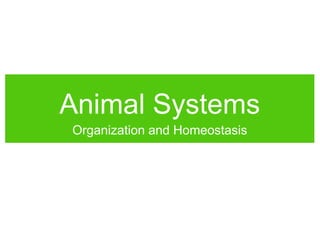animal_systems.ppt
•Descargar como PPT, PDF•
0 recomendaciones•6 vistas
Animal Systems
Denunciar
Compartir
Denunciar
Compartir

Recomendados
Recomendados
Más contenido relacionado
Similar a animal_systems.ppt
Similar a animal_systems.ppt (20)
22.chemical control & coordination in one shot.pptx

22.chemical control & coordination in one shot.pptx
Más de MarianoDelosSantos3
Más de MarianoDelosSantos3 (7)
Último
Último (20)
Justdial Call Girls In Indirapuram, Ghaziabad, 8800357707 Escorts Service

Justdial Call Girls In Indirapuram, Ghaziabad, 8800357707 Escorts Service
dkNET Webinar "Texera: A Scalable Cloud Computing Platform for Sharing Data a...

dkNET Webinar "Texera: A Scalable Cloud Computing Platform for Sharing Data a...
Vip profile Call Girls In Lonavala 9748763073 For Genuine Sex Service At Just...

Vip profile Call Girls In Lonavala 9748763073 For Genuine Sex Service At Just...
Introduction,importance and scope of horticulture.pptx

Introduction,importance and scope of horticulture.pptx
Feature-aligned N-BEATS with Sinkhorn divergence (ICLR '24)

Feature-aligned N-BEATS with Sinkhorn divergence (ICLR '24)
Biogenic Sulfur Gases as Biosignatures on Temperate Sub-Neptune Waterworlds

Biogenic Sulfur Gases as Biosignatures on Temperate Sub-Neptune Waterworlds
Pests of mustard_Identification_Management_Dr.UPR.pdf

Pests of mustard_Identification_Management_Dr.UPR.pdf
Dopamine neurotransmitter determination using graphite sheet- graphene nano-s...

Dopamine neurotransmitter determination using graphite sheet- graphene nano-s...
9999266834 Call Girls In Noida Sector 22 (Delhi) Call Girl Service

9999266834 Call Girls In Noida Sector 22 (Delhi) Call Girl Service
SAMASTIPUR CALL GIRL 7857803690 LOW PRICE ESCORT SERVICE

SAMASTIPUR CALL GIRL 7857803690 LOW PRICE ESCORT SERVICE
animal_systems.ppt
- 1. Animal Systems Organization and Homeostasis
- 2. Which of these is the correct sequence of levels of organization? 1 2 3 33% 33% 33% 1. Organs -> cells -> tissues -> organs 2. Cells -> organs -> organ systems -> tissues 3. Cells -> tissues -> organs -> organ systems
- 3. • Of all human body systems, which do you think is most important. Discuss. Try to explain your answer. W O R K T O G E T H E R
- 4. Organization in Living Things • Cells are organized into tissues • Tissues are organized into organs • Organs are organized into systems • Systems form an organism
- 6. Four tissue types • Epithelial • Connective • Nervous • Muscular
- 7. Epithelial tissue • Epithelial cells form the outer covering, line the internal cavities, and make up the glands. • Examples: Skin, mucous membranes.
- 9. Connective tissue • Consists of living cells in a secreted matrix. • Examples: bone, cartilage, blood.
- 10. Muscular tissue • Specialized protein fibers allow these cells to contract. • Examples: skeletal muscle, smooth muscle, cardiac muscle.
- 11. Nervous tissue • Neurons have the ability to pass an “electrical” signal from one cell to another, or to target cells (muscles, glands, organs).
- 12. Tissues form organs • The skin is an example of an organ made up of multiple tissues: epithelial, muscular, nervous, and connective tissues.
- 13. A group of cells that perform a similar function is know as: 1 2 3 4 25% 25% 25% 25% 1. Tissue 2. Organ 3. Organ system 4. Organism
- 14. One cell type that must undergo continual loss and replacement is: 1 2 3 4 25% 25% 25% 25% 1. Epithelial tissue 2. Connective tissue 3. Muscle tissue 4. Nervous tissue
- 15. Which tissue type is in direct contact with the environment? 1 2 3 4 25% 25% 25% 25% 1. Epithelial 2. Muscle 3. Nervous 4. Connective
- 16. Homeostasis • Homeostasis is the act of keeping the internal environment of a living organism within an acceptable range of conditions. • Homeostasis controls temperature, pH, blood volume, oxygen levels, blood sugar levels, and other conditions. • Negative feedback maintains homeostasis.
- 17. Negative Feedback • Negative feedback keeps conditions within an ideal range. • As conditions exceed the limits of the ideal range, chemical signals (hormones) regulate conditions. Most often this is controlled by the hypothalamus in the brain.
- 18. Positive Feedback • Positive feedback takes a condition out of the normal range, often to some end point. • During labor, oxytocin increases contractions, which stimulate more oxytocin production, until birth occurs.
- 19. Maintaining Temperature • Ectotherms are animals that derive body heat from the environment. Their body temperature may vary widely. • Endotherms rely on metabolic reactions and physiological systems to maintain a steady body temperature.
- 22. Body systems maintain homeostasis through: 1 2 3 33% 33% 33% 1. Positive feedback systems. 2. Negative feedback systems. 3. Uncontrolled feedback systems.
- 23. True or false: “cold blooded” animals always have a lower body temperature than “warm- blooded” animals. 1 2 50% 50% 1. True 2. False
- 24. • Why is positive feedback not a good way to maintain homeostasis? • What are some other examples of positive feedback loops in the human body? • Why do young animals often have more body fat than adults? How does this maintain homeostasis? W O R K T O G E T H E R
- 25. • Draw a negative feedback loop for blood calcium regulation. • Falling calcium level signals release of parathyroid hormone from the parathyroid glands. Calcium is released from bones, increased uptake by digestive system. • Rising calcium level signals release of calcitonin from the thyroid. Blood calcium is taken up into bone tissue. W O R K T O G E T H E R